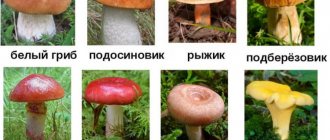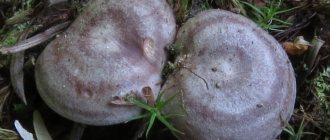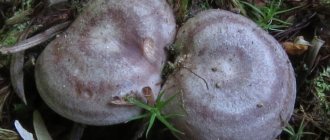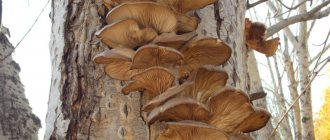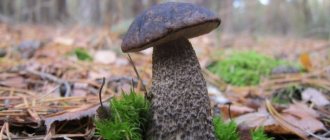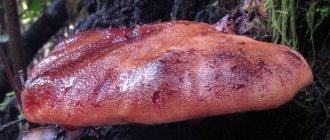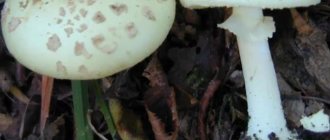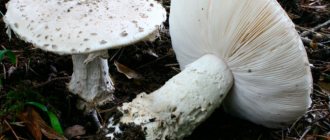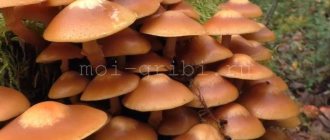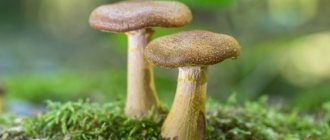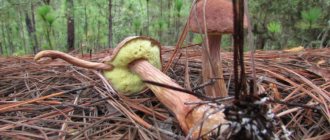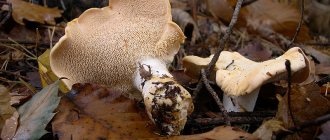Related species
Royal boletus has long belonged to the boletus or boletus genus. The genus is quite numerous and includes about 300 species, among which there are both edible, conditionally edible, and inedible (non-toxic), toxic and poisonous. Therefore, we can say that the royal boletus has many relatives.
Edible species include:
- maiden boletus (brown-yellow boletus) – Boletus appendiculatus;
- bicolor boletus – Boletus bicolor;
- Burroughs boletus – Boletus barrowsii;
- Fechtner's boletus – Boletus fechtneri;
- yellow boletus (yellow boletus) – Boletus junquilleus and others.
The group of inedible, toxic and poisonous species includes:
- beautiful boletus (beautiful boletus) – Boletus calopus – inedible;
- Boletus porosporus (Boletus porosporus) – inedible;
- purple boletus (pink-purple boletus) – Boletus purpureus – inedible;
- legal boletus – Boletus legaliae – toxic;
- beautiful boletus - Boletus pulcherrimus - toxic;
- satanic mushroom – Boletus satanas – toxic, etc.
Similar species and false look-alikes
During a “silent hunt”, the ability to recognize each individual type of mushroom and distinguish it from similar edible species is of great importance. But the most important thing is to learn to distinguish it from inedible and poisonous mushrooms that are similar in appearance, which can harm not only health, but sometimes even human life.
How to distinguish
The royal boletus has a bright, unusual appearance that sets it apart from other representatives of the mushroom kingdom. And if we add here some distinctive features of this species, then we can say that it is difficult for an experienced mushroom picker to confuse it with other mushrooms.
The royal boletus mushroom can create a certain difficulty for identification only for beginners and inexperienced lovers of “silent hunting”. Moreover, if you consider that boletes have quite similar external characteristics, which can vary depending on the habitat, under what tree the mushroom grows, age, etc.
Information! The royal boletus species has the greatest external similarity with its closest relatives - representatives of the boletus or boletus genus, most of which can be eaten.
Each mushroom has its own distinctive characteristics. Here, first of all, you should carefully study the photo and botanical description of the royal boletus and each of the species similar to it. But there are features that distinguish and allow this mushroom to be recognized even at the collection stage:
- The color of the cap is bright, but uneven, spotted - there is a yellowish color, shades of red and brown.
- The color of the royal boletus tubes, depending on age, is lemon yellow, yellow, olive green.
- The leg is also bright – yellowish to light lemon. Red and blue spots can sometimes be seen at the base.
- The leg in the upper part is covered with a thin light yellow mesh.
The importance of studying the differences between toxic and poisonous counterparts is clear and obvious. However, even edible mushrooms can cause serious illness if not properly cooked and consumed. This is especially true for conditionally edible mushrooms and species with a controversial reputation. Mushrooms may also differ in how they are cooked and used in cooking.
Similar edible species
Kele's Oak – Boletus queletii
A mushroom with a controversial reputation: some authors classify it as inedible. Others believe that this species is conditionally edible and can be eaten after mandatory additional pre-culinary processing.
Information! Fortunately, despite having a controversial reputation in Russia, Kele's oak is quite rare and common in the Caucasus, less often in the Far East.
The distinctive features of the Kele oak are:
- The color of the cap is chestnut brown.
- The tubular layer is orange, carrot-brown, and changes to blue when pressed. Whereas the royal boletus is lemon yellow, yellow, olive green.
- The leg, although yellowish in color, is yellow-brown, but noticeably darker.
- The surface of the leg is almost smooth, there is no mesh pattern or scales on it.
- The flesh of the cap is yellowish, the legs are brownish. When cut or broken it turns blue. – The royal boletus has yellowish flesh, both caps and legs.
Information! The fruiting season of the Kele oak tree is May-September.
White pine mushroom – Boletus pinophilus
The royal boletus has a certain external resemblance to one of the varieties of porcini mushroom - the pine porcini mushroom. Another name is porcini mushroom. But given the presence of rather similar external outlines, these two species can only be confused when viewed from afar. Up close, it becomes obvious that the overall color of the royal boletus is brighter and more festive.
Unlike the royal boletus, the white pine mushroom:
- The cap is darker, the color is uneven: in the center it is dark cherry, red, dark brown, chocolate. Closer to the edge it is lighter – pinkish, almost white in young specimens.
- The tubular layer of young mushrooms is white, while that of the royal boletus is clearly lemon yellow.
- The color of the royal boletus leg is bright shades of yellow, yellowish-brown. At the top of the leg there is a thin mesh of light yellow color.
In contrast to the white pine mushroom, which has a whitish or slightly brownish stem. The entire surface is covered with a reddish, light brown mesh pattern, especially pronounced in the upper part.
- The color of the pulp is white, under the skin of the cap it is pink, brownish-red. It does not change when cut or broken. – In the royal boletus, the flesh is light shades of yellow; when cut and broken, it turns blue or blue.
- Forms a partnership, based on the name, most often with pine, less often it settles near spruce, beech, oak, chestnut, hornbeam.
Information! Fruiting season for the white pine mushroom: June – end of October.
Red flywheel – Hortiboletus rubellus
Also, the royal boletus is sometimes confused, especially by novice mushroom pickers, with the red flywheel. Another name is red boletus, red boletus. Previously belonged to the genus Xerocomus of the Boletaceae family. In 2010, it was allocated to a new genus Hortiboletus, also from the Boletaceae family.
The mushroom is edible. Most often used freshly prepared. The distinctive features of the red flywheel are as follows:
- The pores are larger.
- The tubular layer in young specimens is yellow, later dark yellow, olive. When pressed, it slowly turns blue.
- The leg is noticeably thinner - cylindrical, can narrow towards the base, diameter - up to 1 cm. - In the royal boletus, it is massive - on average 2-6 cm.
- The color of the leg is red - raspberry-pinkish, reddish, red-brown, yellow closer to the cap.
- The leg is covered with small scales, while the royal boletus has a mesh.
- The mushroom is quite rare. Distributed in Europe, the Far East
Information! Red flywheel grows from August to September.
Maiden's boletus – Butyriboletus appendiculatus
The closest related species is the royal boletus. It also belongs to the new genus Butyriboletus. Previously included in the genus bolet. Another name is the adnexal boletus. The mushroom is edible. Belongs to the II category of nutritional value.
The differences between the maiden boletus are as follows:
- The cap is golden, reddish-brown, but in more brown tones.
- The color of the tubular layer is initially lemon-yellow, changing to brown-yellow as it grows. Turns blue when pressed.
- The leg is light, lemon-yellow, reddish-brown at the base. When pressed it turns moderately blue.
- The surface of the stem is covered with a light mesh, which is not preserved in older mushrooms.
Information! Maiden's boletus bears fruit in summer and autumn.
Fechtner's Boletus – Butyriboletus fechtneri
Another butyribolete mushroom related to the royal boletus. Another name is Fechtner's disease. The mushroom is edible: consumed fresh or canned.
There are not many differences in description. They are more obvious when comparing photos of the two types.
Information! In Russia, Fechtner's boletus grows in the Caucasus and the Far East.
Compared to the royal boletus, Fechtner's boletus has:
- The color of the cap is noticeably lighter - silvery-white, pale brownish, as if faded.
- The skin can be either smooth or slightly wrinkled.
- The pulp is white. When cut and broken it turns blue.
- There is no smell.
Information! Fruiting season for Fechtner's boletus: June-September.
Inedible look-alikes
Fortunately, there are no poisonous counterparts to the false royal boletus. There is one species that is considered inedible due to the bitter taste of the pulp.
Inedible boletus – Caloboletus calopus
Another name: beautiful-legged boletus, beautiful boletus. Previously belonged to the genus Bolet. Currently it belongs to the genus Caloboletus of the Boletaceae family.
You can recognize this type by:
- The color of the cap is light - light brown, light, grayish-brown.
- The pores of young mushrooms are grayish-yellow, later becoming lemon-yellow with a greenish tint. They turn blue when pressed.
- The color of the leg is bright, there are rich red tones. The surface is covered with a mesh pattern. The upper part is lemon yellow, with white mesh; in the middle – carmine red with red mesh; at the base – brown-red.
- The flesh is whitish, light cream, and turns blue when the cap is cut.
- The taste is initially sweet, but quickly develops a strong bitterness.
- Unlike the royal boletus, which creates a partnership exclusively with deciduous trees, it can also grow under conifers.
Information! The inedible boletus bears fruit from July to October.
Growing methods
The main characteristic feature of eringa is its resistance to viruses and bacterial infections. In addition, this species tolerates storage and transportation well, without losing its taste or appearance at all.
It is important that the cultivation technology is very simple and is much cheaper than, for example, cultivating champignons. For self-cultivation, you need to prepare a substrate
Most often, a log or stump of a deciduous tree is chosen. It is better if it is birch, aspen or alder. You will also need a drill and a pack of mycelium. First you need to inspect the selected tree for damage to rot or other fungi. The thickness of the log should not exceed 30 cm, and its length can be 35-50 cm.
Under natural conditions, growing eringa on wood should begin at the end of April-May, when stable warm weather sets in. These mushrooms can be grown indoors all year round, provided there is heating during the cold season. The optimal temperature will be from 10 to 27 degrees.
Before planting, the prepared wood must be soaked for several days so that the tree is thoroughly saturated with moisture. Next, the tree is taken out and the excess liquid is allowed to drain for several hours. There is no need to leave it for a longer period or expose it to the sun; it may dry out. In the prepared substrate, several holes are made with a drill, with a depth of 4 to 10 cm and a diameter of no more than 1 cm. In order not to introduce mold or bacteria into the mycelium, you should thoroughly wash your hands and wear gloves. The mycelium is then carefully placed into all the pre-drilled holes
Next, they are carefully plugged with wax or covered with wooden plugs
To speed up the germination process, the wood is covered with a bag or coarse cloth. The prepared log with mycelium is placed in a dark, well-ventilated place. The humidity of the substrate must be maintained at a high level. When growing in natural conditions, it is necessary to moisturize not only the wood, but also the ground around it. If done correctly, the substrate will soon be covered with white mycelium. And in about 3-5 months the first harvest of mushrooms will appear.
- If there is no space or it is impossible to use logs, it is possible to grow royal oyster mushrooms in your garden or home. Any room is suitable for this: garage, barn, cellar or basement. Any container can be used as a substrate: plastic bottles, jars, boxes and even plastic bags. It is only necessary to carefully and correctly sow the mycelium and observe certain conditions:
- The temperature should be between +16°C and +27°C.
- Air humidity is not lower than 90%.
- When fruiting begins, you should take care of lighting.
Further, special care will not be needed, since these representatives of the mushroom kingdom are completely unpretentious.
Botanical description
hat
The cap of the royal boletus is round, thick, and fleshy. In young mushrooms, it is hemispherical; as it grows, it gradually opens up and becomes convex, cushion-shaped. In old age, the cap is almost flat, sometimes spread out with a dent in the central part.
The skin of the royal boletus is delicately fibrous, smooth, slightly shiny, and sometimes covered with whitish mesh cracks. Dry, mucous with high humidity and precipitation.
The color is uneven, “marbled” - yellowish, pink, red, bright red, reddish-brown, reddish-violet, sometimes with brown and olive hues may be present at the same time. Small round light spots are also sometimes visible. With age, the color brightens, but in pine forests it can, on the contrary, darken.
Diameter: 5-10, up to 15-20 cm.
Hymenophore
The hymenophore of the royal boletus (the lower part of the cap) is a free tube with a deep notch near the stem. Length: 1-2.5 cm. Pores are small, round or angular.
The color of the tubular layer of the royal boletus is initially lemon yellow, then changes to yellow, olive green.
Spores are smooth, fusiform, ellipsoid. Size: 11-16 x 3-5 microns. Color of royal boletus spore powder: olive-brown, olive-brown.
Leg
The leg is central, massive, solid. The shape is barrel-shaped, tuberous, cylindrical, thickened at the base, but can also taper.
The color of the royal boletus leg is light lemon, bright yellow, yellowish-brown, there may be shades of red and blue (especially at the base). The upper part is covered with a thin light yellow mesh pattern.
Height: 5-15 cm, diameter: 2-6, up to 8 cm.
Pulp
The pulp of the royal boletus is thick, fleshy, dense, strong, and continuous. Color varies from pale yellow to lemon yellow. The base of the stem may be pale pink. When cut and broken, it turns blue or blue.
The taste of the royal boletus is soft, rich, pleasant. The smell is pronounced, mushroom.
Habitat
Royal boletus is most common in North America, including the states of California, Oregon, and Washington. Depending on the region, fruiting is rare or quite abundant.
In Eurasia, the mushroom is quite rare. In Russia, it is more common in the Caucasus, as well as in Transbaikalia and the Far East (less often). It can also be found in some regions of Ukraine, in particular in the Carpathian and Transcarpathian regions.
Prefers calcareous and sandy soils. Grows in small groups or singly.
Where does it grow
Royal boletus forms mycorrhiza (symbiosis with the roots of the plant) with deciduous trees, with preference for beech and oak.
Based on this, the royal boletus has become widespread in deciduous, mainly beech and oak, as well as mixed forests.
Option No. 2
Another option is to take a fairly mature bronze boletus and soak it in a bucket of water.
Some people recommend adding a packet of yeast to the water. After a day, knead the cap with your hands. Strain the resulting mixture. Throw away the grounds, and pour the liquid, which contains a lot of fungal spores, under a tree - a potential symbiont. If there are several such trees, you can water them all if you wish; the spores in one cap are enough for 4,200 liter barrels of seed solution. If the weather is dry, water the planting areas once a week. Sowing bronze boletuses in open ground does not provide a 100% guarantee of results, although if the technology is followed, the probability of getting a mushroom plantation is quite high. However, there is a way to breed boletus mushrooms indoors. This is a much more labor- and capital-intensive task, but success is more likely in this case.
To grow bronze Bolets, you will need two clean, dry rooms, in which it is necessary to carry out anti-mold treatment, then thoroughly ventilate and dry. It is necessary to think over and install ventilation, watering, heating systems, as well as fluorescent lamps.
To germinate spores, you will need the first room. It should be darkened, the humidity in it should be at least 95%, and the temperature should be 23-25 oC.
To ripen the fruiting bodies, you need ventilation for a good supply of oxygen, a lower (12-18 oC) temperature and daylight for at least 3-4 hours a day (lamp are also suitable). Excess moisture here will do harm; one or more, depending on the size of the room, containers with water will be enough.
You should choose planting material based on recommendations and reviews. Check the mycelium before paying: healthy mycelium is orange-yellowish. It should not have a trace of ammonia smell; such mycelium was overheated during storage and is now non-viable.
The substrate for sowing is made from any plant waste and forest litter is added to it. There should be no mold or rot anywhere! All this must be mixed, crushed and steamed for 3 hours with water, the temperature of which is maintained at 70-80 oC. Then the excess water is drained and the mixture is allowed to cool to room temperature. Take a handful of substrate. It should compress easily without releasing excess water. If there is any, then you need to let it drain for up to several days.
Inoculate the substrate with mycelium in a sterile, sealed (ventilation turned off, doors and windows closed) room, wearing sterile gloves, strictly following the instructions on the package. The mycelium is crushed directly in the package and opened only later. Mycelium is added to the substrate in a ratio of 3-5:100 if it is produced in Russia, and 1.5-2.5:100 if it is produced in Europe. Everything is mixed and packaged in polypropylene bags or planting boxes. Cross-shaped incisions about 1 cm long are made in the bags using a sterile scalpel blade. All that remains is to place the bags on the shelves in the germination room so that the distance between them is at least 5 cm.
After a month, the bags are transferred to the germination room. The usual lifespan of such planting is up to six months. This allows you to timely introduce fresh mycelium for germination.
How to collect
Royal boletus begins to bear fruit early: depending on the region, this is May-June. The last mushrooms can be found at the end of September. Although in some areas this species grows in October. In this case, the peak of fruiting occurs at the end of June - beginning of July.
Important! Mushrooms tend to accumulate all kinds of toxins and heavy metals from the soil. Therefore, to harvest royal boletus, you need to choose environmentally friendly places, away from industrial enterprises, roads, etc.
As with most mushrooms, when collecting, preference should be given to young specimens. Mature fruiting bodies are more damaged by worms and pests, as well as rotting and mold, and taste also suffers.
Since worms, as a rule, begin to eat the mushroom from the base of the stem, even at the stage of collecting the royal boletus, it would be a good idea to carefully examine the cut.
Important! If plastic bags were used for collection, then in any case the mushrooms should be poured as quickly as possible, for example, into baskets - the fruiting bodies must “breathe”. It is unacceptable to keep collected mushrooms in closed bags, this reduces storage time and leads to their rapid spoilage.
Interesting Facts
Boletus Regius.
- Boletuses are one of the most massive and fastest growing mushrooms. The sizes of individual specimens reach a weight of up to 3 kg.
- The beginning of the period of active collection of boletus mushrooms coincides with the beginning of the appearance of the red fly agaric in the forest.
- The name “boletus” coincides with the nickname of the ancient Slavic spirit of the forest, related to the goblin. According to legend, he is the patron of mushrooms and berries and can give a person a rich harvest or, on the contrary, take them away with nothing. And he himself is capable of turning into a mushroom.
- Boletuses of all types never grow in young forests, only in old ones, no younger than half a century.
How to process
Royal boletus, like most mushrooms, is a perishable product and needs to be processed as quickly as possible after harvesting. Experts determine this period from 12 to 24 hours. In the refrigerator it can be extended up to 2-3 days.
However, it should be taken into account that if the fruiting body contains small traces of rotting, as well as hidden worms, then it begins to deteriorate rapidly and the worms infect neighboring, healthy specimens.
Important! The longer the mushroom is stored unprocessed, the greater the loss of nutrients in its composition.
The beneficial properties of the royal boletus include the fact that its pre-culinary processing is minimal: special cleaning, as well as preliminary long-term soaking or boiling, is not required.
Housewives, when they first become acquainted with this species, are often interested in how to process the royal boletus. The general scheme of pre-culinary processing is as follows:
- The mushrooms are sorted out and carefully examined, removing forest debris and discarding old, suspicious, and also specimens severely damaged by worms and rot.
- Then the fruiting bodies are wiped with a soft brush or rag to remove forest debris and dirt adhering to them. Use a sharp knife to scrape off stubborn dirt and cut out areas affected by rot and pests. The lower part of the leg is also cut off.
- At the next stage, the royal boletus mushrooms are washed. To do this, first fill them with water and thoroughly wash each specimen separately, and then all together, changing the water several times.
Next, the mushrooms are soaked in salted water for 15 minutes. After this, the water is drained and the fruiting bodies are washed well several times, while changing the water. Then put it in a colander and let the water drain.
Important! Mushrooms intended for drying and freezing should not be washed.
- After washing, the royal boletuses are carefully inspected again for the presence of rotten and pest-damaged areas, which are removed.
Rub the entire surface of the fruiting body with your hand. If the skin peels off in some place, this is an indicator of spoilage. This skin, as well as part of the pulp under it, is also cut out.
- And finally, the royal boletus is washed under running water and placed in a colander to drain.
Advice! Mushrooms intended for cooking can be strained less thoroughly, as they will still be in the water. You should keep the royal boletus mushrooms in a colander for more time, the method of use of which is supposed to be frying or stewing.
Fungotherapy - principles of therapy with medicinal mushrooms
However, no medicine can be trusted as a panacea. People have always tended to generalize and exaggerate.
Did it help one? This means it will help everyone and everything. However, such an opinion is fundamentally wrong and even dangerous!
A fungotherapist should not have a vague idea of what beneficial properties an extract of medicinal mushrooms of one type or another has, like a sales representative, but clearly understand the mechanisms of disease development and the points at which a mushroom medicine can interrupt it.
That is why, when contacting a specialist, it is important to find out whether he follows the following principles of treatment:
- Each disease has its own mushroom. It is unacceptable to be treated with “what is in stock”;
- You cannot avoid consultations and treatment with doctors of official medicine. This is especially true for the possibility of using medicinal mushrooms for oncology: they only strengthen the body’s immunity, but are not able to destroy the tumor on their own;
- When selecting a formal treatment regimen, it is necessary to inform the doctor about the fact of using fungotherapy;
- When using mushrooms, you must strictly follow the prescribed regimen; you cannot exceed or decrease the dose yourself;
- It is prohibited to take mushroom medicine without a prescription from a fungotherapist.
Medicinal forms of medicinal mushrooms
There are many ways to take medicinal mushrooms.
Basically, these are infusions, decoctions, powder extracts in capsules..
They are taken orally, used as inhalation solutions (for example, inhalation with chaga for laryngeal cancer), compresses and lotions are made with them, and even taken in baths.
In addition, there are ointments and creams made from mushroom raw materials (for example, from fly agarics).
Medicines based on medicinal mushrooms
Mushrooms contain unique polysaccharides, such as beta-glucans and other five- and six-carbon heteropolysaccharides, not present anywhere else in nature, which help enhance the natural recognition response of immune cells!!!
How to store
Royal boletus in ready-made dishes has an exceptional taste and is very aromatic. And in this respect, it is in no way inferior to its more eminent and well-known brother - the porcini mushroom.
The mushroom is universal and can be used in any type of preparation for the winter. The bright and rich taste and aroma of the royal boletus have proven themselves excellent in canning, both as a mono component and as part of vegetable stews.
The simplest and most widely used way to preserve royal boletus for use out of season is drying. This is an especially good solution if the harvest is rich and there is very little time to process it. It’s also worth considering that you don’t need to wash and boil the mushrooms first, just clean them properly.
Drying can be done outdoors. It is also permissible to use a gas oven, microwave or Russian oven, as well as a special dryer.
Old, overdried, broken specimens also find use: they are ground into powder in any convenient way, and then used as an aromatic seasoning in the preparation of soups, sauces, and main courses.
Information! The calorie content of dried royal boletus is 286 kcal per 100 grams. product.
Many lovers of mushroom cooking are interested in whether and how to store royal boletus in the refrigerator. Freezing is also a fairly quick and economical way to preserve the harvested crop until spring without loss of nutrients in the fruiting bodies. In this case, a semi-finished product is obtained, immediately ready for the main culinary processing.
For this type of preparation, there is no need to pre-boil the mushrooms. Just as with drying, washing is replaced by wiping the surface of each fruiting body with a damp rag.
Then the pre-prepared mushrooms are placed in containers or zip bags and frozen. It should be noted that it is unacceptable to defrost and then re-freeze royal boletus, as this leads to their damage. Therefore, the mushrooms are divided into portions so that one is enough to prepare one dish.
Important! Since mushrooms easily absorb foreign odors, frozen king boletus should be kept away from strong-smelling foods such as fish, etc.
And, of course, there are few people who can resist the unique taste and aroma of salted or pickled mushrooms. According to fans of mushroom cooking, it is in its pickled form that the high taste qualities of the royal boletus are most fully revealed.
Beneficial features
They say about the porcini mushroom that it is a storehouse of nutrients. The product contains trace elements that are necessary for humans to overcome many diseases.
Beneficial features:
- Contains selenium. It prevents “activated cancer” cells from multiplying.
- The chemical composition includes vitamin C. The properties of ascorbic acid make it possible to maintain the vitality of the human body. Appetite improves, the immune system is restored, and insomnia disappears.
- All types of porcini mushrooms contain vital material for our bones - calcium. By including this product in your diet, you will compensate for the lack of the following microelements - iron, potassium, and B vitamins, which will help improve memory, restore the functioning of the nervous system, and restore blood circulation in the brain.
- Helps cleanse the blood.
- Vitamin A is essential for maintaining beautiful and healthy skin.
- Eating porcini mushrooms will help regulate the functioning of the thyroid gland.
In cooking
Royal boletus is highly valued and is very popular in cooking. Considered a delicacy. Just like porcini mushroom, it can be eaten not only cooked, but also raw, for example, in salads.
Belongs to the I, highest category of nutritional value. It has a soft, rich, pleasant taste and a pronounced mushroom aroma. The pulp is thick, fleshy, dense, elastic. Even in adulthood, there are no voids or cavities in the fruiting bodies. During cooking, it retains its shape and texture well and does not fall apart.
The mushroom is universal and you don’t have to think about how to cook the royal boletus; it is suitable for all types of processing - it is boiled, fried, stewed. It reveals its taste well, both as an independent dish and as part of other ingredients. It goes well with both meat and various vegetables, including potatoes, cereals, and pasta.
Based on this, there are many different recipes for royal boletus.
Information! Royal boletus is a low-calorie product. The calorie content of the mushroom is 34 kcal per 100 g. product.
Damage to boletus
Boletus is not suitable for feeding children
The energy value of porcini mushroom is high, but at the same time you should be careful. It is strictly contraindicated during pregnancy and for feeding children.
Negative characteristic:
- The life cycle of the porcini mushroom is extremely short, so it is easy to get poisoned by it (the overripe fruiting body).
- They are difficult to digest, which sometimes causes digestive system upset.
- The chitin content negatively affects kidney function.
- Absorbs harmful substances from the environment.
- The “kings” of the forest are strong allergens, so they should be consumed with great caution.
- There are poisonous counterparts, in particular the gall fungus. These mushrooms can be easily distinguished by the color of the hymenophore. The gall boletus has a red inner cap, and it also has a looser pulp structure.
The value of porcini mushroom is unique, but when consuming this product, be careful, focusing on your health, because if not processed correctly, it releases harmful substances.
